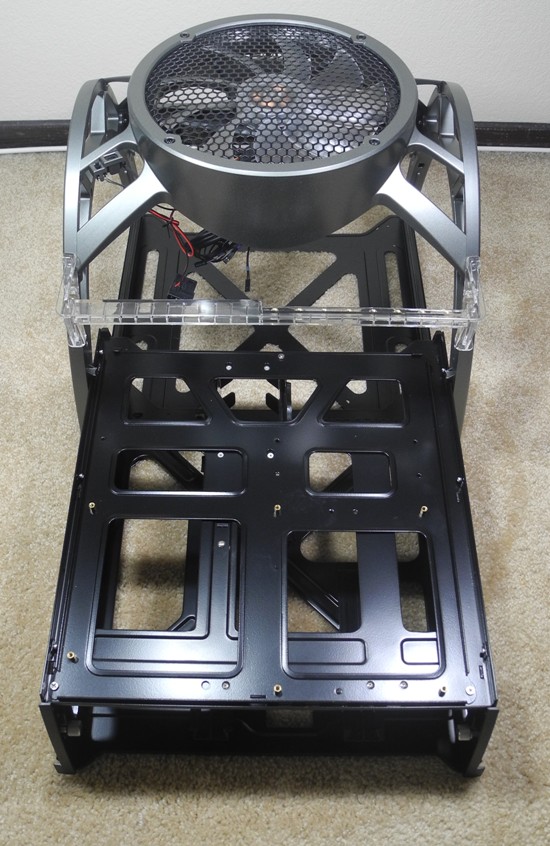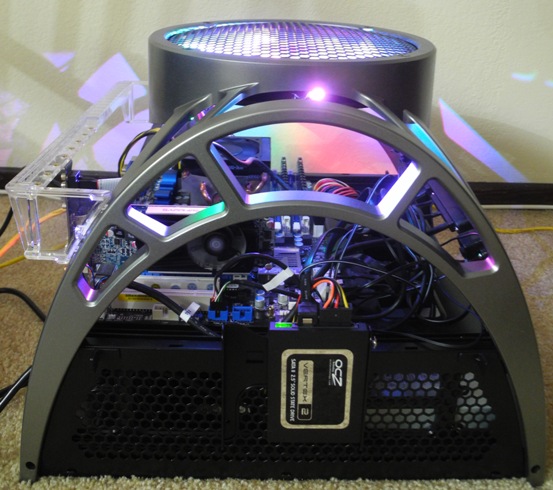AMD A8-3850 : An HTPC Perspective
by Ganesh T S on June 30, 2011 6:20 AM EST
AMD provided us with an A8-3850 CPU and an ASRock A75Pro4 ATX motherboard for the review. Purists might balk at the idea of a 100W TDP processor being used in tests intended to test the HTPC capabilities. However, we have to make do with whatever sample was sent to us. A look at the Lynx lineup indicates that the same product with a 2.6 GHz core clock (A8-3800) has a 65W TDP. I intended to underclock the CPU to 2.6 GHz. However, Llano clock adjustments are a minefield, as Ian points out in his ASRock Extreme6 review. The idle power usage in my testbed was good enough (as we shall see in a later section). My time was better spent debugging the HTPC related issues, and therefore, I didn't take the trouble to underclock.
As soon as I finished setting up the testbed, I found that Blu-rays would play correctly, but local file playback had a host of issues. Noise reduction and cadence detection wouldn't get activated for local files with ESVP on. Turning it off resulted in dropped frames and high load on the GPU. It was turning out to be very similar to the DDR3 based MSI 6450 we had reviewed earlier.
Being a new platform, BIOS updates for the ASRock A75 Pro4 were flying thick and fast. To confound the issue, different BIOS versions had different behaviors with the default UEFI settings. With some BIOS versions, even Blu-ray playback had the same issues as local files.
After going back and forth with AMD about the local file playback issue, we discovered that the BR softwares use a proprietary API for video playback from discs with DRM. For local file playback, most players use the DXVA API. These are different code paths and may result in different GPU utilization numbers.
Couple of days back, AMD finally discovered that the BIOS was forcing the shared GPU memory to an absurdly low value. The GFX memory settings forced by the user in the BIOS were also not honored. There was an update to the BIOS to fix this and set the default GFX memory to 512 MB. After this, both Blu-ray and local file playback improved enough for us to be able to get down to exhaustive testing. AMD did acknowledge that there exists an issue with local file playback having higher than normal GPU utilization, but that hasn't been resolved as yet.
The table below lists the components in our Llano HTPC testbed.
| AMD Llano HTPC Testbed Setup | |
| Processor | AMD A8-3850 - 2.90GHz, 4MB Cache (1MB/core) |
| Motherboard | ASRock A75Pro4 ATX |
| OS Drive | OCZ Vertex 2 120 GB |
| Memory | G.Skill Ripjaws Series 4GB (2 x 2GB) SDRAM DDR3 1333 (PC3 10666) F3-10666CL7D-4GBRH CAS 7-7-7-21 |
| Video Cards | None / Sapphire DDR3 6570 (for Crossfire) |
| Optical Drives | ASUS 8X Blu-ray Drive Model BC-08B1ST |
| Case | Antec Skeleton ATX Open Air Case |
| Power Supply | Antec VP-450 450W ATX |
| Operating System | Windows 7 Ultimate x64 |
| Display / AVR | Acer H243H / Onkyo TX-SR 606 + Toshiba Regza 37RV530U |
| . | |
The most important part of the testbed from a reviewer's perspective was the open air case from Antec. I had used the Antec VERIS Fusion MAX for the NAS / Fall 2010 HTPC testbed. The case was a HTPC beauty, and kept my lab neat and orderly (instead of having components all over the table and the floor). However, the fact that I had to open the case to swap PCI-E cards in and out made it slightly impractical.
The Antec Skeleton is a full ATX open air enclosure, and what really sealed the deal for me was the fact that the motherboard was easily accessible, and upto 4 SATA drives could be mounted on the side. It also has support for upto three 11" PCI-E cards. There are Quick Relase 5.25" and 3.5" bays, but I chose to mount only one optical drive in the 5.25" bay, leaving the rest open to route the cables. The four externally mounted 3.5" bays can also be used to mount 2.5" drives, as I did with the OCZ Vertex 2 SSD in the gallery below.
I keep moving my testbeds back and forth between the home theater setup with the bitstreaming / 24 Hz capable gear and the test lab upstairs with the ordinary monitors (so as to not disturb my family's usage of the HT gear). In the Antec Skeleton case, the grips on the top railing (on either side of the top fan) can be used as handles. This makes it very easy to carry around.
The fancy LED lights on top around the huge fan make it look very attractive and it is sure to turn heads.
The last thing was from an OC / gaming enthusiast viewpoint and not really from a reviewer's perspective!
Let us now proceed to the actual HTPC benchmarking of the Llano.


















104 Comments
View All Comments
Targon - Friday, July 1, 2011 - link
New vs. open box....it's like comparing the price of a used car vs. a new car, it's not in the same market.Yes, a car that is three years old drops in value by 45-55 percent, so you can get a used car that is better in most respects for the same money, but who knows how the original owner treated the car, if there are problems, etc. Buying new vs. used....
You will be able to get an open box AMD motherboard for super-cheap too, so where's your advantage once THAT happens?
maroon1 - Friday, July 1, 2011 - link
Obviously, 4GB DDR3 1600MHz for $38 is going to have poor timing, and it is not going to performs as good as the one that anandtech tested
rockrr - Saturday, July 2, 2011 - link
I’m not a technowiz like many of the AT readers are, (I read AR to learn.) I am a gamer and build my own machines. I agree that the ability to upgrade CPU and GPU separately is cost effective and allows for customizing for the best performance to suit your needs. Also it allows for recycling of components to upgrade other systems.Anato - Thursday, June 30, 2011 - link
Couldn't agree more. There is feeling that no way AT could let AMD to be good at something. In mobile market there was this magical performance metric i7-2630QM+GTX460M (which obviously is not a competitor to Llano) on top of the char.And yes AMD is not as good as Intel at x86 but the whole point of Llano is different. AMD clearly chose to set more area for the GPU and make it affordable as a platform.
In general would be better to compare what user can get with given price range. CPU-price is only 1/2 of the story, then there is motherboard and Intel chipped motherboards are generally more expensive.
prdola0 - Thursday, June 30, 2011 - link
That is entirely untrue now. It used to be the case but that time is now gone (it has been for a while, but you obviously missed it). It gets even better with H61.maroon1 - Friday, July 1, 2011 - link
No one would buy a P67 unless you want to use discrete GPUA good quality H67 can be found as cheap as $75
http://www.newegg.com/Product/Product.aspx?Item=N8...
And H61 cost only $60
http://www.newegg.com/Product/Product.aspx?Item=N8...
http://www.newegg.com/Product/Product.aspx?Item=N8...
ganeshts - Thursday, June 30, 2011 - link
duploxxx, I agree wtih you on almost all the points.But, AMD has a good discrete GPU background now and taken in that context, the HTPC performance is not up to the mark.
People don't care about post processing if they can't even play their camcorder videos. With a proper dGPU (targeted towards HTPCs), they can play and also get post processing done on the same clip. Why is the ESVP feature enabled by default when it doesn't work as intended?
When I heard about the high end Llano, I expected it to fully replace the discrete HTPC GPU. Unfortunately, that is not happening (pending some magical driver updates?)
kev18 - Thursday, July 7, 2011 - link
i second the comment made.....I have an AMD based HTPC already......i was excited to hear the new integrated CPU/GPU and may be it is time to upgrade..... but after hearing the problem playing files on hard drive, I think i willl wait for this to be more mature before buying........may be i should consider buying a 6xxx GPU card so that i can get HD-DTSGigantopithecus - Thursday, June 30, 2011 - link
Thanks for the review, Ganesh. I have a quick question: though the Antec Skeleton is a far less than ideal testbed for an HTPC, do you have any numbers or subjective impressions of the noisiness of the stock HSF?Also, from your reported power consumption numbers, your setup should run on an external power brick or picoPSU. The Antec PSU you used is a bottom-barrel model that's not even 80+, and during local HD file playback, is pulling ~10% of the PSU's rated output. That is, you're at the bottom end of the efficiency curve of a non-efficient PSU. It would be nice to see idealized or even more accurate power consumption numbers. Furthermore, I understand that you can only benchmark what you're actually sent, but as an HTPC builder, I'm having trouble thinking of a scenario when I would use the A8-3850 for HTPC duties...
Finally, when you say "our expectations from the desktop Llano were much higher," well, what were you expecting? The issues with BRD and HD video file playback all sound like software, not hardware problems. Llano's not for sale on Newegg, so hopefully AMD will work out the kinks with its partners before or shortly after retail availability. I personally am extremely impressed by the power consumption numbers. Depending on the cost of the lower-end Llano SKUs and assuming they provide good enough computing (I can't wait for an HD 6410D APU to be tested), I'll likely cease building i3-based HTPCs.
ganeshts - Thursday, June 30, 2011 - link
We were provided an ATX motherboard for review with the 100W TDP processor. Our benchmarking setup was chosen with future reviews in mind too. We had no idea is mind how the power consumption numbers would play out before choosing the PSU.Today is the launch date for the processor. So, this review is just an inkling of how the 6550D (which is also there in the A8-3800 with 65W TDP) will perform currently for HTPC duties. It is targeted towards DIYers who want to build a HTPC right away (and our conclusion is, wait and watch for a few driver releases).